Paul Gilbert Interview
8th Air Force Bomber Pilot

Webmaster: You were out of high school at the time the Japanese bombed Pearl Harbor?
I was working odd jobs in the LA area and finally found a good job at a grocery store that paid 75 cents a day. This was on a Friday, when I came to work on Monday I was told that my job was only for the weekend so I had to go home and tell my folks I was no longer employed.

Later I attended UCLA and eventually was hired by an accounting firm in downtown Los Angeles. This was in 1939. I was returning from a job in Bakersfield when the war broke out. Everyone was patriotic and "gung ho" to get in the service. I was 25 at the time and you had to be under 26 to get into the Air Corps so I just barely made it. Because I was supporting my parents, I had a deferment from the draft but I wanted to go anyway. My boss tried to talk me out of it but I was determined. Besides I had the urge to fly. I had never been off the ground in my life and wanted to be a pilot.
Upon enlistment, I expected to go to Santa Ana where they were training all the local pilots. I would get my uniform and go home and show it off to my parents. It didn't work out that way. I was in the first group to be shipped to Nashville, Tennessee. The base there was not ready for occupancy and we stood in the rain waiting for our physicals. I wanted to impress the army so I was wearing my best suit which was now drenched. I sailed through the classification test and had my choice of assignments so I chose pilot.
Mission Schedule 1944
June 6.....Santrecount
July 18....Kiel
July 19....Schweinfurt
July 20....Leipzig
July 25....StLo
July 28....Merseburg
July 29....Merseburg
July 31....Munich
Aug 2......Courtalain
Aug 4......Bremen
Aug 5......Magleburg
Aug 8......France
Aug 9......Eindhoven
Aug 12.....Rouhland
Aug 26.....Brest
Aug 27.....Germany
Sept 5.....Stutgart
Sept 8.....Mainz
Sept 17....Arnem Deelen
Sept 25....Ludwigshaven
Sept 30....Bielefeld
Oct 2......Kassel
Oct 5......Handrof
Oct 6......Berlin
Oct 7......Lutskendorf
Oct 9......Mainz
Oct 12.....Bremen
Oct 17.....Cologn
Oct 18.....Kassel
Oct 25.....Hamburg
Oct 26.....Hanover
Nov 6......Rheydt
Nov 9......Saarbrucken
Nov 11.....Overlahnstein
|
Webmaster: Where was your primary pilot training?
Thunderbird, Arizona where I flew PT-17 Stearmans. Flying became very easy for me. I was gifted with good coordination and was the first one in my class to solo. They had civilian instructors with five cadets assigned to each. After we soloed, the instructor would instruct us on what maneuvers to practice and one day, it was spins. One of our five entered the maneuver but failed to recover and was killed in front of us. That kind of shook us all up.
Webmaster: Was your basic training also in Arizona?
Yes, but at Marana, Arizona where we flew BT-13s a two seater open cockpit airplane called the Vultee Vibrator. After that we went to advanced and flew a twin engine Beechcraft which was difficult to fly and was very touchy.
Webmaster: You never flew an AT6?
I did after I came back from the war but not in training. AT6s were used for fighter pilots and the Beechcraft was used for bomber pilots.
Webmaster: So during your early training, you chose to be a bomber pilot?
I had a choice somewhere in basic. I took bombers because I thought it would be less hazardous. This was probably the biggest mistake I ever made. As it turned out it was just the opposite. The transition from the BT-13 to the Beechcraft was very difficult but the transition from the Beech to the B-17 was easy. I remember the first time I got in a B-17, I stood behind the pilot and watched him. I felt that I would never be able to learn how to handle all that technology--the controls, the instruments. But the B-17 turned out that is was easy and a very flyable airplane. Towards the end of the war, we were jockeying those B-17s around like fighters. Remember you had to fly tight formations and were on controls all the time. The safety in flying combat is in tight formations because that way you could concentrate your firepower on the enemy. It was the stragglers who got shot down.
Webmaster: After advanced training you graduate and got your wings. Where was that?
Marfa, Texas. From there I went to Salt Lake City to indoctrinate and meet my crew for the first time. And from there we went to Norman, Oklahoma. I can tell you that it was not love at first sight. They thought I was over-disciplined and a hard-ass. My goal was to survive and I felt if I trained my crew well, our chances of surviving would be a lot better.
The first flight with my crew was a disaster. I was supposed to have an experienced navigator but this guy didn't know where we were. We ended up turning a short flight into a cross-country and I had to home in on the beacon at Norman. The crew had to think they had been assigned to a real bad pilot who got lost on his first flight. From Norman we went to Roswell, New Mexico for formation flying and gunnery practice. From here we were ordered overseas.
|
The following pictures are of Paul Gilbert's B-17 or taken from his B-17.
|
Webmaster: Where did you arrive in England?
Preswick, Scotland then Stone, England. I was assigned to the 452nd. Bomb Group in East Anglia.
Webmaster: What were your missions like?
The German equipment was well engineered and efficient. The ME-109 and FW-190s were very capable fighters and at the beginning of the war they had very good pilots. Toward the end of the war, they ran out of good pilots. They had the 88 which was the finest piece of artillery in the war. Some of the larger targets like Berlin was well
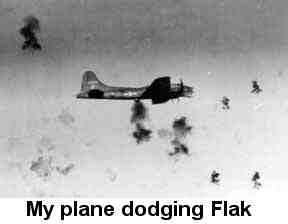 defended with 88s and our losses there were high. We went over Berlin twice and were hit often. We always had pieces of the airplane shot away--tips of the wing or parts of the control surfaces would always seem to get hit. It sounded like someone threw gravel at the plane and when you heard that, you knew you were being hit. When you looked behind you and saw how black it was, you wondered how you made it through. Over the target you fly straight and level. The bombardier takes over the plane and this is the most hazardous part of the mission.
defended with 88s and our losses there were high. We went over Berlin twice and were hit often. We always had pieces of the airplane shot away--tips of the wing or parts of the control surfaces would always seem to get hit. It sounded like someone threw gravel at the plane and when you heard that, you knew you were being hit. When you looked behind you and saw how black it was, you wondered how you made it through. Over the target you fly straight and level. The bombardier takes over the plane and this is the most hazardous part of the mission.
Once you drop your bombs, you get out of there in a hurry. At this point, it is quite a relief because the plane is lighter and quicker and you have survived the worst. Most of the time we carried 500 pounders but when we hit the submarine pens, we carried 1000 pounders because of the heavier fortifications protecting the installations. We could only get two of those bombs in the bombay so we carried one under each wing in external racks. Our main targets were the marshaling yards, the ball bearing plants, the IG Farben plant and the airfields. It seemed to us after awhile that is was somewhat for naught because the German's had pre-fabbed material in the hills and as soon as we hit a plant, they would have it up and running the next day and we would have to hit them again. Like I said earlier, they were very efficient.
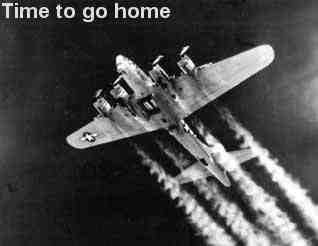
Webmaster: How about your first mission?
There was always a plane designated as "Deputy Plane." The purpose of this plane was to follow along behind the group and if a plane was knocked out, the deputy plane would move up and fill in. In our first mission, we were that deputy. Sure enough before we got over the target, a plane dropped out and we moved to fill their spot. We knew we were in the war because we could feel pieces of plane being shot off. You never get used to that feeling but for our first mission, it was terrifying.
Webmaster: Your first mission of June 8, 1944 right after D-Day. When you left on a mission, how many planes would be in the mission?
Minimum 400-500 but more than likely 1,000 planes--this included the decoys.
Webmaster: Your missions started later in the war. Did the German's have an air defense at that time?
 Very much so. We were hit by Messerschmidts often coming in at 12 o'clock high. I could see the pilots very clearly and see the pink lights blinking at us which meant that they were shooting at us. As the war went on, there were fewer and fewer of them.
Very much so. We were hit by Messerschmidts often coming in at 12 o'clock high. I could see the pilots very clearly and see the pink lights blinking at us which meant that they were shooting at us. As the war went on, there were fewer and fewer of them.
I did see jet fighters although none actually attacked us. I finished my 35 missions in November.
Webmaster: You were shot down on your 13th mission? What was the target?
We were on the way to Eindhoven, Germany and we lost two engines to anti-aircraft gunnery during that long flight. Our longest mission was eleven and a half hours and our shortest one was about five or six hours when we hit targets on the coastline.

Our crew had one of the fewest number of aborted missions of anyone in our group. Not because I was so brave but because I wanted to get the missions over with as fast as we could and I didn't think you could predict a good mission or a bad one so I just took them all as they came. On this flight to Einhoven when I lost those two engines, I was forced to abort. The way you announced your intention to abort is you dropped your landing gear and that was the indication to the group that you were leaving.
Webmaster: Where are you right now?
Central Germany. We were at somewhere between 25 thousand and 30 thousand feet. As we were leaving the formation, I started losing power in the third engine and our plane was pretty well shot up with holes in the wings and tail assembly. We were losing about 500' per minute. It was obvious that we weren't going to make it back to England. I advised the crew and asked them if they wanted to land here and become POWs or ditch in the North Sea. "What do you want to do?" I asked them. Everyone voted to ditch.
Webmaster: I assume you dumped all your bombs.

We dumped all our bombs, our drums but we did not dump the ball turret because we were trying to ditch. We threw everything out except that. Over occupied Belgium they started shooting at us but somehow we evaded all this anti-aircraft fire. It was a miracle with all those guns trained on us that we didn't get hit. I maneuvered as much as I could under the circumstances so that may have helped.
At this point the plane was hardly flyable. All our radios were shot out and with only one engine running, the plane kept sliding off. Fortunately a couple of our fighters picked us up but they were low on gas and finally had to leave us. We finally reached the North Sea and started preparing to ditch. The crew is trained to sit next to each other in the radio room and put their hands forward to brace against the shock. As I neared the water, I couldn't see too well because spray was hitting the windshield so I had my head stuck out of the cockpit and as a result, I made a poor landing and slammed into the water and broke the plane in two at the radio room. There was time enough for everyone to get out with the life preserves. We didn't get any other equipment out because the plane sunk within a minute. We failed to get the direction finder which would help in our rescue.
Our biggest problem was cold. We saw some planes in a distance but they didn't see our flares. We didn't know if we would survive the night. All of a sudden, two Lockheed Hudsons came straight in for us and dropped supplies including a larger life raft that had a chemical heater. Finally a launch came and picked us up.
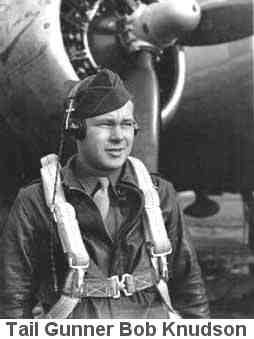 I went up to the Captain of the launch and asked him how he found us. He said he couldn't tell us because it was classified. I had to know so I pressed the issue saying, "You gotta tell me!" He said he would but I couldn't tell the crew. I agreed. At that time, radar was highly classified and those Hudsons were equipped with airborne radar and the life raft had reflective material on it. I'm here today because of radar. A couple of P-51s also came out to protect us until the launch picked us up.
I went up to the Captain of the launch and asked him how he found us. He said he couldn't tell us because it was classified. I had to know so I pressed the issue saying, "You gotta tell me!" He said he would but I couldn't tell the crew. I agreed. At that time, radar was highly classified and those Hudsons were equipped with airborne radar and the life raft had reflective material on it. I'm here today because of radar. A couple of P-51s also came out to protect us until the launch picked us up.
We stayed in the hospital overnight but were all OK. I had been struck with a piece of flack but the biggest problem was exposure. We got back to the base the next day and discovered that they were packing up our things to send back home. We got that stopped.
They sent us on R&R in South Hampton. We were staying in a big English manor that had been prepared for R&R.
Webmaster: What was the name of this plane that went down?
"Merchant of Menace." The second plane, after they sent me a bill for $50,000 to pay for the plane I lost, was "That's All Brother."
Webmaster: What was your bomb group?
452nd. Bomb Group
Webmaster: As your missions progressed, the allies were pushing the Germans farther and farther away from the coast. This had to help.
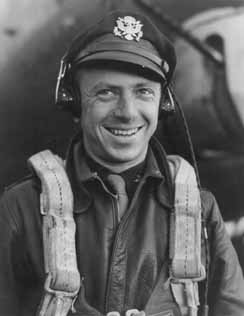 During our briefings before a mission. We could see those enemy lines being moved back which meant we traveled over more and more territory before encountering enemy action. There was one Army General named George Patton who was moving so fast and pushing the enemy back at a tremendous rate. If he had not been held back by Eisenhower, Bradley, Montgomery and Roosevelt, I am sure he would have taken Berlin and we would not have had the wall.
During our briefings before a mission. We could see those enemy lines being moved back which meant we traveled over more and more territory before encountering enemy action. There was one Army General named George Patton who was moving so fast and pushing the enemy back at a tremendous rate. If he had not been held back by Eisenhower, Bradley, Montgomery and Roosevelt, I am sure he would have taken Berlin and we would not have had the wall.
Webmaster: You now have completed your 35 missions. Those members of your crew, along with you, who have completed those missions are finished? Are you out of the service?
Yes, we are through with those dangerous mission and most go home. I was retained to train new crews in England. I flew my crew back to Liverpool so they could get on a boat and go home. It was there that we said our good-byes.
Webmaster: Do you ever see any of your crew now?
They were having annual meetings which I didn't know about and they found me in 1992 for the first time. They invited me to their annual meeting in Orlando. It was quite an emotional time for me. It had been 40 years and there is certainly a bond that exists between us. Most of the meeting time is devoted to talking about what went on during those missions. The pilot sits up front and doesn't always know what is going on.
Webmaster: Thank you for your time and your service to our country.

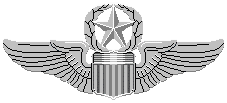

|